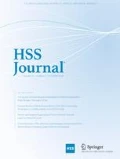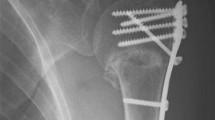Abstract
Background
The speed and degree of functional recovery over time after surgery for tibial shaft fracture has been previously described using subjective methods.
Questions/Purpose
This study aimed to quantitatively measure recovery of isokinetic strength in the injured leg after surgical repair of isolated closed tibial shaft fracture.
Methods
In this prospective case series, patients were recruited after intramedullary nailing for isolated closed tibial shaft fracture at an academic medical center from January 2012 to December 2015. Recovery of isokinetic strength was quantified using an isokinetic dynamometer. Eight measures of isokinetic strength at 3, 6, and 12 months’ follow-up were used to compare strength in the injured leg to the healthy leg.
Results
In 36 patients recruited, there was a significant difference in strength between the healthy and injured legs at 3 months for seven of the eight metrics used, at 6 months for five of the eight metrics, and at 12 months for none of the eight metrics. Observing recovery of strength longitudinally, we saw significant improvement between 3 and 6 months for four of eight metrics and overall between 3 and 12 months for five of the eight metrics. All four metrics that showed a significant improvement between 3 and 6 months involved plantar flexion. No metrics showed significant improvement between 6 and 12 months.
Conclusions
Patients exhibited equal strength between their healthy and injured legs at 12 months after surgery. Improvement in strength occurred to a greater extent between 3 and 6 months after surgery than between 6 and 12 months. Plantar flexion appeared to improve more rapidly than dorsal extension.
Similar content being viewed by others
References
Aydog E, Aydog ST, Cakci A, Doral MN. Reliability of isokinetic ankle inversion- and eversion-strength measurement in neutral foot position, using the Biodex dynamometer. Knee Surg Sports Traumatol Arthrosc. 2004;12:478–481.
Bone LB, Sucato D, Stegemann PM, Rohrbacher BJ. Displaced isolated fractures of the tibial shaft treated with either a cast or intramedullary nailing. J Bone Joint Surg Am. 1997;79-A 9:1336–1341.
Busse JW, Morton E, Lacchetti C, et al. Current management of tibial shaft fractures: a survey of 450 Canadian orthopedic trauma surgeons. Acta Orthop. 2008;79:689–694.
Court-Brown CM, McBirnie J. The epidemiology of tibial fractures. J Bone Joint Surg Br. 1995;77:417–421.
Drouin JM, Valovich-McLeod TC, Shultz SJ, et al. Reliability and validity of the Biodex system 3 pro isokinetic dynamometer velocity, torque and position measurements. Eur J Appl Physiol. 2004;91:22–29.
Finkemeier CG, Schmidt AH, Kyle RF, et al. A prospective, randomized study of intramedullary nails inserted with and without reaming for the treatment of open and closed fractures of the tibial shaft. J Orthop Trauma. 2000;14:187–193.
Frink M, Klaus A, Kuther G, et al. Long term results of compartment syndrome of the lower limb in polytraumatised patients. Injury. 2007;28:607–613.
Harris PA, Taylor R, Thielke R, et al. Research electronic data capture (REDCap)—a metadata-driven methodology and workflow process for providing translational research informatics support. J Biomed Inform. 2009;42:377–381.
Holmback AM, Porter MM, Downham D, Lexell J. Ankle dorsiflexor muscle performance in healthy young men and women: reliability of eccentric peak torque and work measurements. J Rehabil Med. 2001;33:90–96.
Hothorn T, Bretz F, Westfall P. Simultaneous inference in general parametric models. Biom J. 2008;50(3):346–363.
Kakar S, Tornetta III P. Open fractures of the tibia treated by immediate intramedullary tibial nail insertion without reaming: a prospective study. J Orthop Trauma. 2007;21(3):153–157.
Khalily C, Behnke S, Seligson D. Treatment of closed tibia shaft fractures: a survey from the 1997 Orthopaedic Trauma Association and Osteosynthesis International–Gerhard Küntscher Kreis meeting. J Orthop Trauma. 2000;14:577–581.
Kwasnicki R, Hettiaratchy S, Okogbaa J, Lo B, Yang G-Z, Darzi A. Return of functional mobility after an open tibial fracture. A sensor-based longitudinal cohort study using the Hamlyn Mobility Score. Bone Joint J. 2015;97-B:1118–1125.
Lin CA, Swiontkowski M, Bhandari M, et al. Reaming does not affect functional outcomes after open and closed tibial shaft fractures: the results of a randomized controlled trial. J Orthop Trauma. 2016;30:142–148.
Pinheiro J, Bates D, DebRoy S, Sarkar D. nlme: Linear and nonlinear mixed effects models. R package version 3.1–131.1. 2018. Available at https://CRAN.R-project.org/package=nlme. Accessed 21 Dec 2016.
R Core Team. R: a language and environment for statistical computing. R Foundation for Statistical Computing. Available at https://www.R-project.org. Accessed 21 Dec 2016.
Russell TA. Fractures of the tibial diaphysis. In: Levine AM, ed. Orthopedic Knowledge Update: Trauma. Rosemont: American Academy of Orthopedic Surgeons;1996:171–179.
Vailler HA, Cureton BA, Patterson BM. Factors influencing functional outcomes after distal tibia shaft fractures. J Orthop Trauma. 2012;26(3):178–183.
Author information
Authors and Affiliations
Corresponding author
Ethics declarations
Conflict of Interest
Alexandra I. Goodwin, BA, Brittany E. Haws, BS, Ziyad O. Knio, BS, Per Kristian Moerk, DPT, PT, and Anna N. Miller, MD, FACS, declare that they have no conflicts of interest.
Human/Animal Rights
All procedures followed were in accordance with the ethical standards of the responsible committee on human experimentation (institutional and national) and with the Helsinki Declaration of 1975, as revised in 2013.
Informed Consent
Informed consent was obtained from all patients included in this study.
Required Author Forms
Disclosure forms provided by the authors are available with the online version of this article.
Additional information
Level of Evidence: Level III, Prognostic Study (Prospective Case Series)
Rights and permissions
About this article
Cite this article
Goodwin, A.I., Haws, B.E., Knio, Z.O. et al. Isokinetic Strength Testing Following Intramedullary Nailing of Tibial Shaft Fractures Predicts Time to Recovery and Return of Muscle Strength in the Injured Extremity: A Prospective Case Series. HSS Jrnl 14, 266–270 (2018). https://doi.org/10.1007/s11420-018-9611-y
Received:
Accepted:
Published:
Issue Date:
DOI: https://doi.org/10.1007/s11420-018-9611-y




